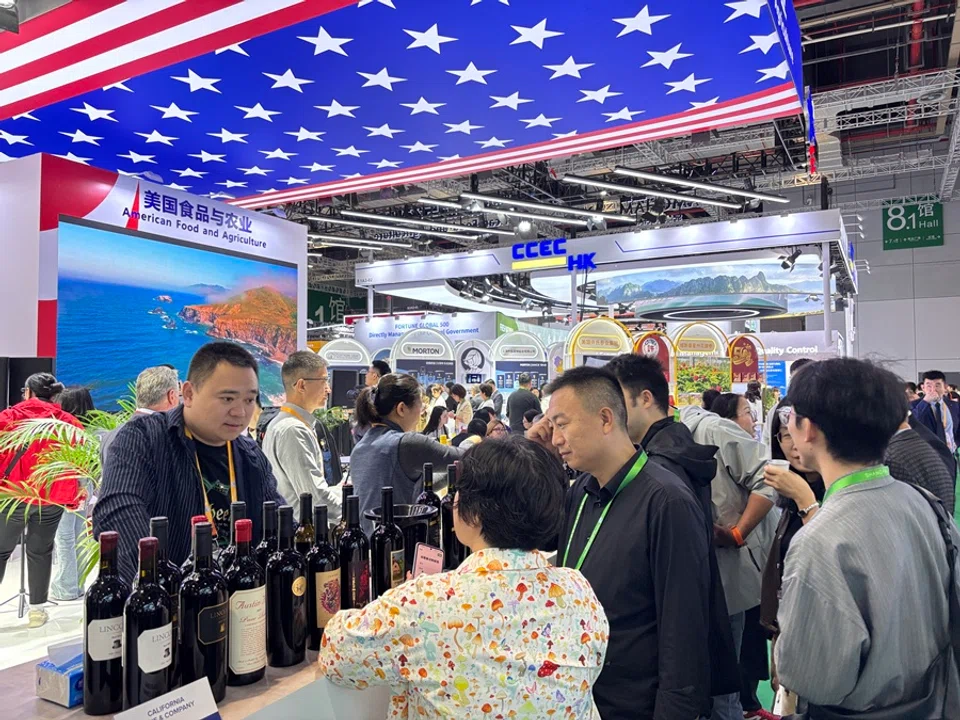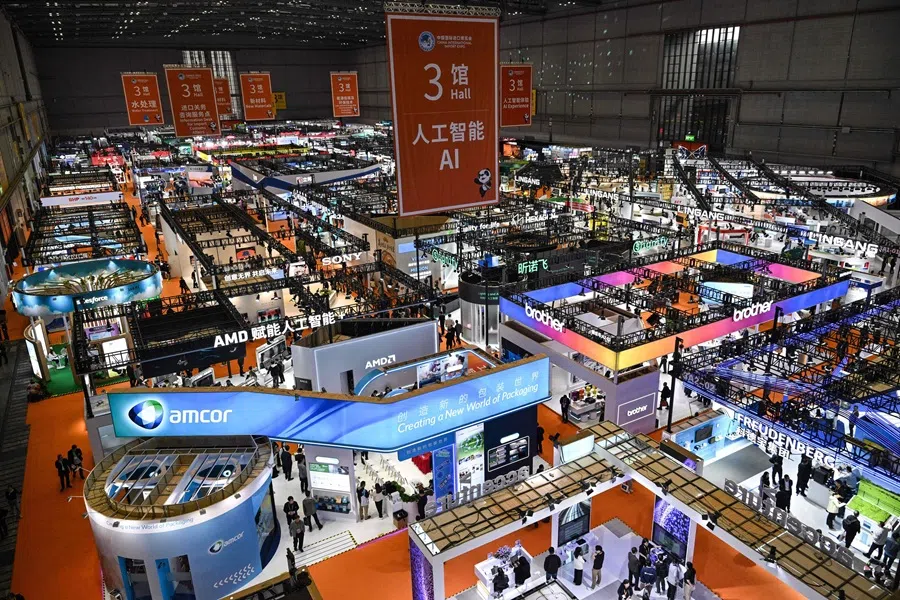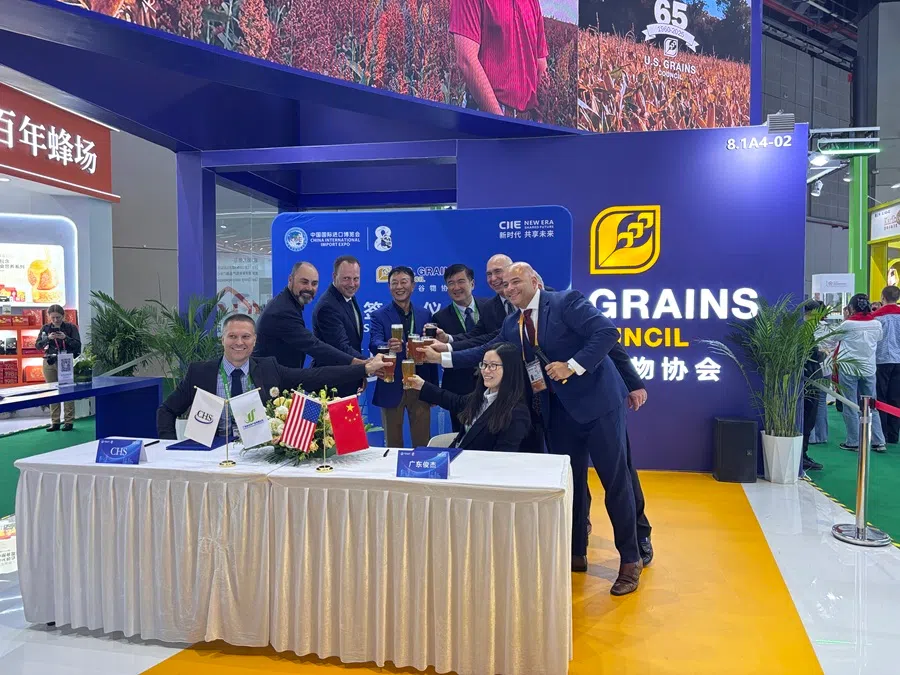Tariffs can’t stop them: How US farmers are winning Chinese tables
Despite trade tensions and shifting tariffs, American farmers are finding ways to keep their products — chicken feet, soybeans and more — on Chinese tables. Lianhe Zaobao correspondent Li Kang observed at this year’s China International Import Expo in Shanghai how determined US farmers and traders are to ensure business continues, no matter the obstacles.

As soon as I stepped into the US agricultural products pavilion, I was surrounded by the aroma of sizzling steak. Across the aisle, representatives from the U.S. Grains & BioProducts Council raised their beer glasses in celebration of a successful deal.
At this year’s China International Import Expo (CIIE), the American Food and Agriculture Pavilion was bustling with visitors soon after opening on the morning of 6 November.
Beijing’s tariff adjustments
A day prior, on 5 November, China’s Customs Tariff Commission of the State Council announced that, starting 10 November, additional tariffs on certain US-origin agricultural products would be lifted. It also extended for another year the reduced tariff rate on US goods, previously lowered from 24% to 10%.
Earlier this year, effective from 10 March, China had imposed an additional 15% tariff on US chicken, wheat, corn and cotton; and an additional 10% tariff on sorghum, soybeans, pork, beef, aquatic products, fruits, vegetables and dairy products.
For American agricultural producers who had travelled all the way to Shanghai for the expo, this latest tariff adjustment from Beijing was a godsend.
... the most imported American poultry product in China is not chicken breast, wings or nuggets, but chicken feet. They even offered a tip for telling them apart: “If it’s big and weighs over 40 grams, it’s definitely from the US.”

On 6 November, after witnessing Chinese and American companies reach cooperation deals at the CIIE, Mark Wilson, chairman of the U.S. Grains & BioProducts Council, told me on the sidelines of the expo that a shipment of sorghum had already been loaded and was on its way to China. “Hopefully that’s a good sign and we’ll continue to see more,” he said.
Meanwhile, a snaking line of Chinese visitors waited to sample the wines at the California wine booth. According to a staff member, a 750ml bottle of red wine sells for about 150 RMB (US$21). Although tariffs remain above 70%, that is still “much better” than when the rate peaked at 128%.
American products and Chinese consumer trends
American companies have not missed a year of the CIIE since its inception in 2018. China’s evolving consumer trends in recent years are also reflected in the products brought by American exhibitors. This year, Illinois-based food company Kabod made its debut at the expo, presenting cornbread and coffee cubes to win over the sweet tooth of China’s younger generation.
In the meantime, Idaho-based animal feed and nutrition company Dynamite tapped into China’s booming pet economy of recent years, bringing a range of pet probiotics, supplements and immunity pastes — all designed to pamper the country’s beloved “fur babies”. The products are carefully made with locally sourced ingredients — one digestive health capsule, for instance, uses cold spring trout from the snow mountain regions.
... the China-US trade war was at its peak, yet American companies were already preparing to occupy over 50,000 square metres of exhibition space, ranking first among all participating countries for seven consecutive years.

At the USA Poultry and Egg Export Council booth, the staff shared a piece of trivia about China–US poultry trade: the most imported American poultry product in China is not chicken breast, wings or nuggets, but chicken feet. They even offered a tip for telling them apart: “If it’s big and weighs over 40 grams, it’s definitely from the US.”
In recent months, high-level officials from China and the US have been jostling at the negotiating table, while thousands of American chicken feet have made their way onto Chinese dining tables. As they munch on these chicken feet, how many Chinese people realise that they are dining on an imported product that has travelled thousands of miles across the ocean?
Much like the chicken feet on the tables, despite the fluctuations in the trade wars and tariffs, business between Chinese and American importers and exporters has never ceased. They continue to find opportunities for cooperation in the slightest margins of trade, even uncovering new business prospects in the already slim-margin agricultural sector.
The situation mirrors this year’s CIIE. In the months ahead of the exhibition, the China-US trade war was at its peak, yet American companies were already preparing to occupy over 50,000 square metres of exhibition space, ranking first among all participating countries for seven consecutive years. The American Food and Agriculture Pavilion, set up by the American Chamber of Commerce in Shanghai and the US Department of Agriculture, has been a fixture at the CIIE for three years. This year, the exhibition area reached 350 square metres, with 19 exhibitors, both record highs.
US and China economies are complementary
These figures reflect one facet of China–US economic and trade relations: the economies of the two countries are highly complementary. American companies are reluctant to — and indeed cannot afford to — lose the Chinese market. U.S. Grains & BioProducts Council’s Wilson stated candidly that his visit to Shanghai was to “help maintain the friendships that we fostered over the last 43 years” and to “remind people that we’re here. We didn’t fall away, we’re not going anywhere.”
... an industry insider from the US Soybean Export Council revealed that US soybeans have a high refining rate at low cost, offering advantages that Brazilian or other origin soybeans cannot replace.

The recent focus on soybeans presents a different picture at the CIIE. Although there were no US soybeans imported by China in September, an industry insider from the US Soybean Export Council revealed that US soybeans have a high refining rate at low cost, offering advantages that Brazilian or other origin soybeans cannot replace. Hence, even when China temporarily halted imports, American traders were not worried, commenting, “We were just waiting for the restrictions to ease; the markets are inherently complementary.”
Another facet of China–US economic and trade relations is that beneath the warming of bilateral relations and the harmonious atmosphere at the CIIE, everything appears to be unchanged — yet change is evident. The backdrop of strategic competition between the US and China dictates that economic and trade tensions will persist in the long run.
Following two 90-day tariff truces, the US and China have entered a year of tariff easing. A respite of 12 months is undoubtedly better than three, but following that, the uncertainty in China–US economic and trade relations is still set to persist indefinitely.

During the CIIE, Eric Zheng, president of the American Chamber of Commerce in Shanghai, said that over US$500 million in cooperation agreements were signed between the US and China during the exhibition in 2023; last year, this figure soared to US$711 million.
When I asked Zheng about this year’s expectations, he did not provide a number immediately, only expressing hope to once again set a new record. “Even with the Busan summit, companies will not be quick to sign deals; it will still take some time.”
This article was first published in Lianhe Zaobao as “进博会美国馆一片祥和”.





